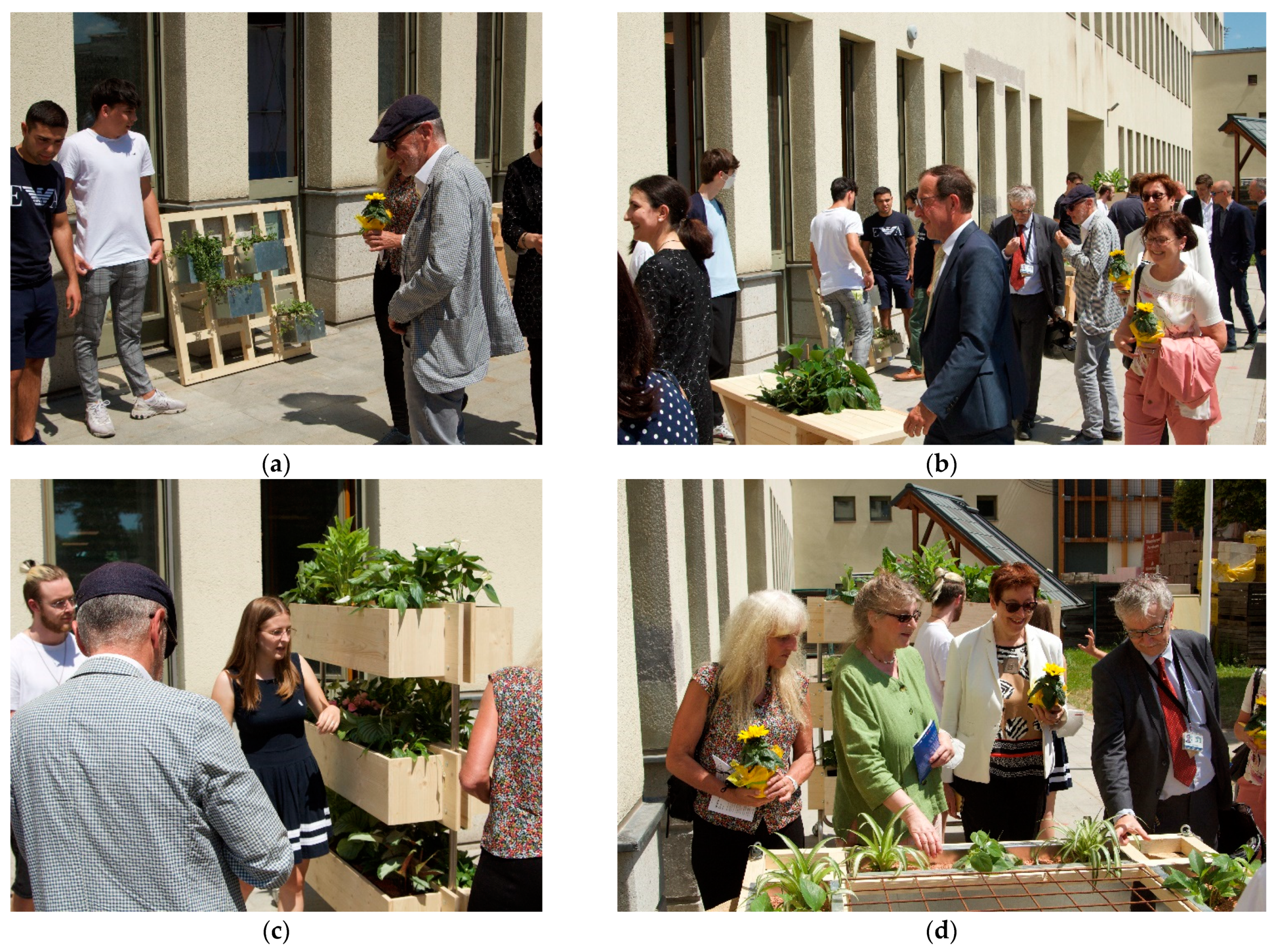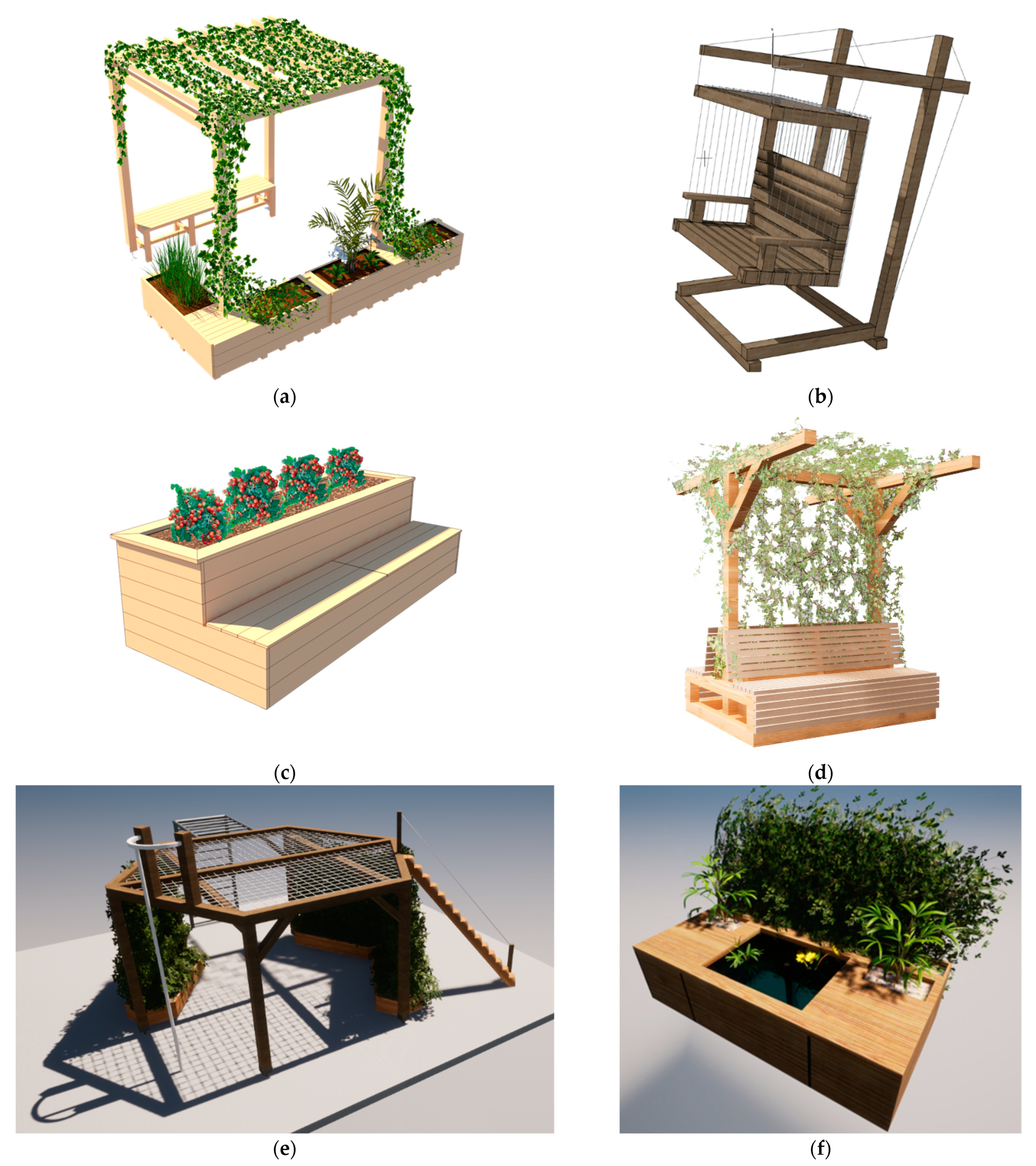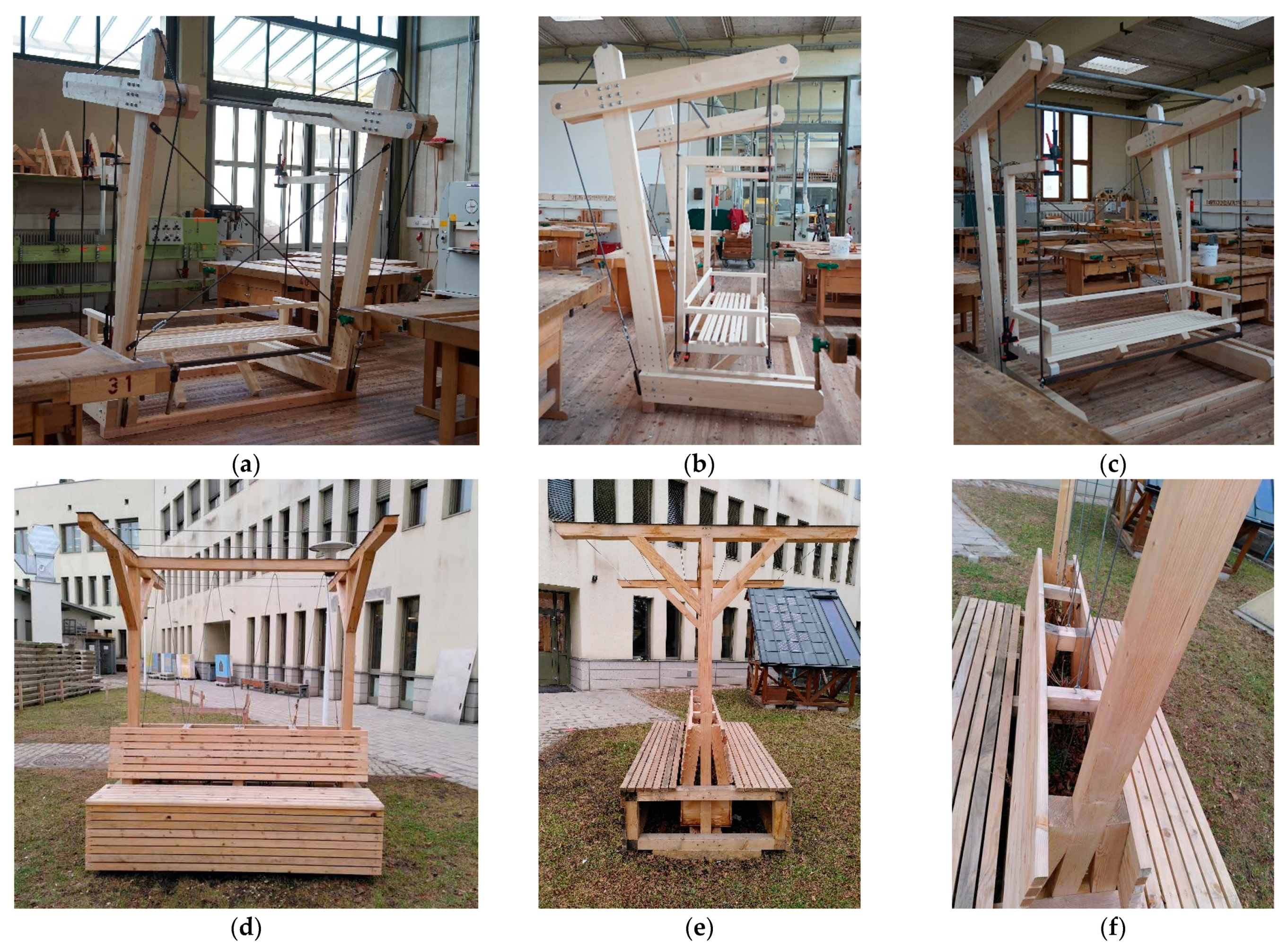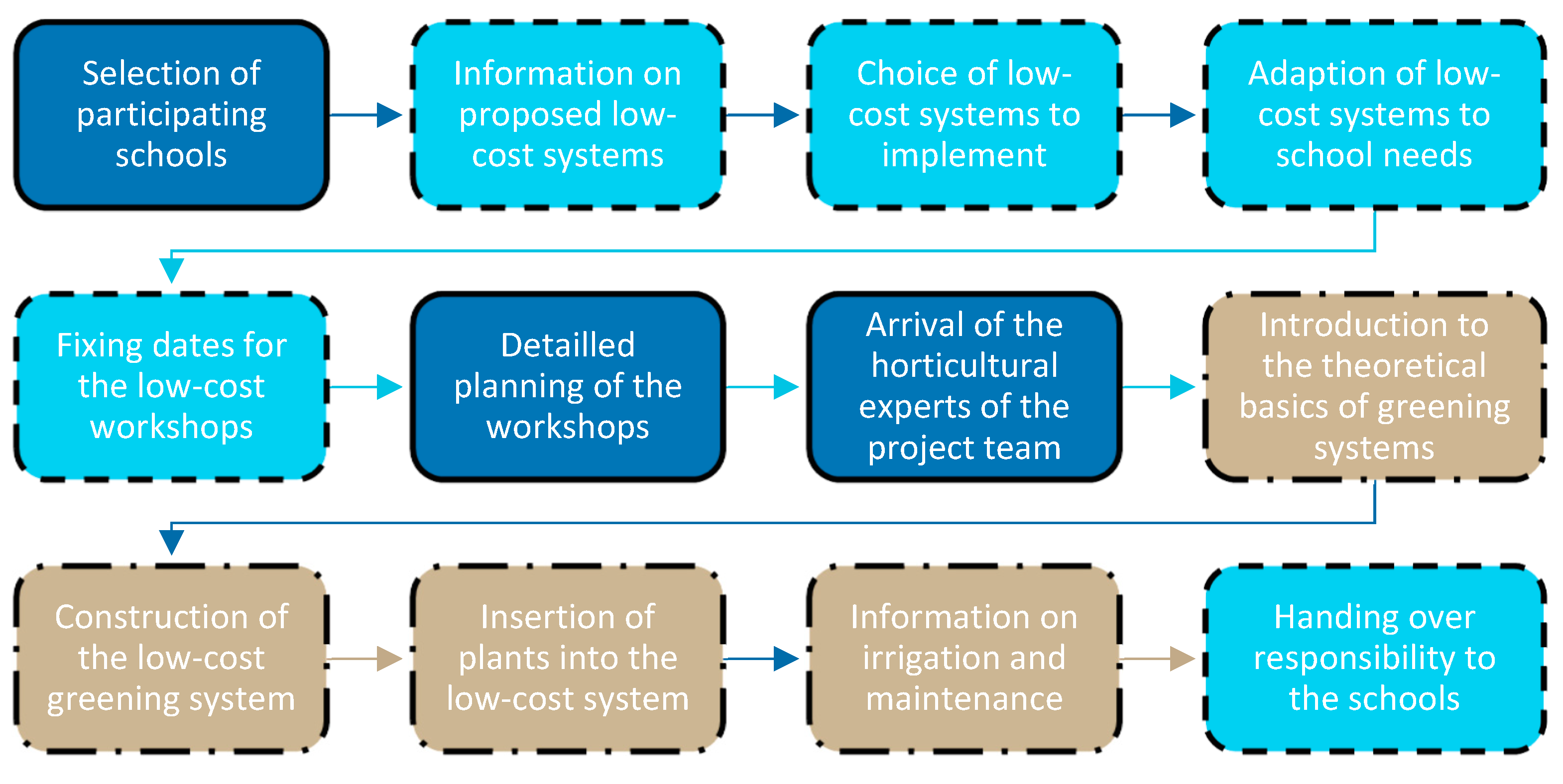Cross-School Collaboration to Develop and Implement Self-Construction Greening Systems for Schools
Abstract
1. Introduction
2. Results
2.1. Greening Systems for School Interiors and Facades
- Facade greening system “The Green Plug”:This specially shaped molded brick, which can be produced by pressing, can be used to form continuous troughs for a greened clinker facade with tongue and groove joints. The system, like most clinker facades, follows the principle of a ventilated facade, which must be fixed at regular intervals by dowelling to the supporting wall structure. Irrigation can be provided by simple drip hoses.Planting—for facade application: Hosta tardiana, Fuchsia magellanica, Bergenia cordifolia, Heuchera micrantha, Arum italicum, Brunnera macrophylla; for indoor application: Calathea makoyana, Begonia maculata, Peperomia, Chlorophytum comosum, Monstera adansonii, Syngonium podophyllum.
- Clinker brick facade trough:This facade greening system consists of 80 cm high and 100 cm wide brick troughs that can be placed on top of each other in a tongue and groove system. Due to the large troughs, the plants have plenty of root space, which also serves to store water and therefore requires less watering. Here, too, fastening to the outer wall construction is done by facade anchors. Mounting on interior walls is also possible in principle, although in this case it may be advantageous to reduce the dimensions of the troughs.Planting—for facade application: Festuca glauca, Hylotelephium telephium, Sempervivum, Yucca gloriosa, Cotoneaster dammeri, Campanula poscharskyana, Thymus praecox, Phlox subulate, Hypericum, Rosmarinus officinalis.
- Modular wall greening system:This is a modular greening system with a grid-shaped wooden substructure, which is intended for mounting on a load-bearing interior wall. The plant troughs, made of sheet metal, can be hung in any position on the wooden grid structure and vary in their dimensions. This allows for individual adaptability in terms of size and plant density of the overall system.Planting—for indoor application: Senecio rowleyanus, Callisa repens, Ficus pumila, Ceropegia linearis, Calathea, Peperomia glabella, Chlorophytum comosum, Adiantum capillus-veneris.
- Greened seating furniture “Green Domino”:The idea of this greening system is to create a large-scale seating landscape, e.g., for auditoriums or break rooms, by arranging several elements rotated by 90° in a domino-like manner. This invites students to linger in a green oasis and encourages them to change the arrangements of the individual furniture according to their needs. Wheels attached to the bottom allow easy movement of the wooden greening system, which is made without metal connectors.Planting—for indoor application: Senecio rowleyanus, Syngonium podophyllum, Zantedeschia aethiopica, Epipremnum aureum, Peperomia obtusifolia, Philodendron erubescens, Maranta leuconeura, Aglaonema commutatum, Ficus pumila, Ctenanthe burle-marxii.
- Plantable mobile partition:The original design of this system utilizes a used heavy-duty clothes bar, which is converted into a greening system by simple adaptation. For the design at the CSBT’s construction yard, the variant with wooden greening troughs on both sides was chosen. These were lined with pond foil and have an integrated water storage layer, enabling a design without water drainage.Planting—for indoor application: Bergenia, Spathiphyllum calathea, Adiantum raddianum, Aglaonema commutatum, Anthurium andreanum.
- Greened hanging system “Green Cloud”:This flat greening system is suspended from the ceiling if the room is high enough, creating a “green cloud” above the heads of students and teachers. The square wooden grid construction has a metal lattice in the center. The four elongated aluminum troughs are placed in the openings of the wooden structure, allowing the plants to grow over the metal lattice and hang down from the outer sides.Planting—for indoor application: Chlorophytum, Asparagus densiflorus, Philodendron, Monstera, Tradiscantie, Acalypha hispida, Nematanthus gregarious, Nephrolepis exaltata, Hoya, Epipremnum aureum.
2.2. Greening Systems for School Open Space
- “GreenClassroom” greened pergola:This spacious pergola allows outdoor classes to be held (the “open space classroom” principle) and can be used for individual purposes during breaks. Due to its modularity, it is possible to adapt the dimensions to the intended class size. Stretching from one wooden pillar to the next, planting troughs with climbing support for various plants are provided to green the pergola as much as possible. The addition of opaque wall and ceiling panels with respect to year-round usability of the pergola has been considered.Planting—for outdoor application: Clematis alpina, Wisteria floribunda, Actinidia arguta, Vitis vinifera, Rosa lucieae.
- Plantable hanging chair “Green Trio”:The name originated from the idea of always arranging three such hanging chairs around a central area, e.g., an existing tree, thus increasing the tilt resistance of the individual hanging chairs in addition to their special appearance. This greening system, like the other systems, is primarily made of wood, but it also has load-bearing steel cables with which the hanging chair is suspended from the supporting structure. The greenery is provided by climbing plants, which are inserted either into the existing soil or into wooden troughs that can be positioned behind the hanging chair.Planting—for outdoor application: Clerodendrum thomsoniae, Lonicera caprifolium.
- Raised bed “The Vessel”:The special features of this raised bed are the integrated seating area and the storage space underneath for all sorts of garden utensils. The construction is made entirely of wood. The walls of the raised bed facing the soil body should be protected from moisture by a waterproofing membrane. The raised bed should be permeable to the soil below to avoid water accumulation and allow soil organisms to bond with the new soil body. A small-meshed grid avoids the entry of voles.Planting—for outdoor application: all kinds of fruits, vegetables and herbs, such as berries, salads, zucchini, squash, onion, rosemary, hyssop, etc.
- Greened pergola “T-Bench”:This pergola was named for its shape, which resembles a T. In the center of the pergola is a plant trough for the climbing plants in order to cover the roof, providing the desired shade. Benches are placed on either side of the planting trough, hiding the trough and allowing the climbing plants to grow out of the gap between the benches. An alternative design for the T-Bench is to omit the bench on one side and instead provide a place to park bicycles.Planting—for outdoor application: Vitis silvestris, Hedera helix, Clematis, Phaseolus coccineus, Thunbergia alata, Ipomoea, Tropaeolum.
- Pergola with play equipment “Place Evergreen”:Inspired by the shape of a honeycomb, this pergola has six sides of equal length and can thus be extended by another honeycomb element on each side. The design provides for two different modules that can be combined with each other as requested: on the one hand, a playground module with various playground equipment and a climbing net on the roof and, on the other hand, a relaxation module with Holly- wood swings and a green roof.Planting—for outdoor application: Clematis alpina, Wisteria floribunda, Actinidia arguta, Vitis vinifera, Rosa lucieae.
- Greened fountain:This greening system is designed to create a feel-good oasis for hot summer days: In the center is a water area with water plants and a solar fountain. The seating areas next to it are bordered on the back by a green wall of climbing plants on a climbing scaffold. The watering of the climbing plants is solar-powered as well.Planting—for outdoor application: Euonymus fortunei, Clematis alpina, Lonicera caprifolium, Pygmaea Chrysantha, Hydrocharis morsus-ranae, Hottonia palustris, Stratiotes aloides, Hippuris vulgaris, Veronica beccabunga.
2.3. Results of the Greening Workshops in the Federal States
- Korneuburg (Lower Austria):The implemented greening system corresponds to a double version of the pergola “T-Bench”, which was erected on concrete slabs. The climbing plants were inserted directly into the ground. The sides of the benches were covered for visual reasons. For the care of the plants, the backrest on one side of the bench can be removed with only a few screws.
- Wörgl (Tyrol):The implementation is based on the greened pergola “Green Classroom”, whereby the dimensions were adapted to minimize the wood waste. In one corner, a free space was provided for the integration of a stove, which will be retrofitted by the school.
- St. Johann (Salzburg):Since the school in St. Johann already had a large-scale climbing trellis on several exterior wall surfaces, but the old climbing plants had already died, the principal decided to use the existing trellis and add new climbing plants. Therefore, no further greening system was implemented here.
- Maria Gail (Carinthia):For the elementary school in Maria Gail near Villach, the principle of the mobile green partition was adapted and simplified for safety reasons. Instead of the clothes rail the construction was made of wood. Since the construction of such a greening system is not feasible with elementary school children, the wooden construction was prefabricated in Vienna, so that only the fleece, the substrate and the plants had to be inserted at the workshop.
- Graz (Styria):In the high school in Graz, the same mobile green walls were erected as in Maria Gail. In contrast to the elementary school, however, the wooden construction was built together with students from the upper school, which promoted the interaction of different age groups and school levels.
- Kirchdorf (Upper Austria):Like Wörgl, a slightly modified version of the “Green Classroom” pergola was built in Kirchdorf. Here, the plant troughs as well as the bench are arranged on one side only, so that people sit with their back to the sports field, with a certain separation provided by the greenery.
- Neusiedl (Burgenland):At the Pannoneum Neusiedl School of Economics and Tourism, a raised bed for the independent cultivation of fruit and vegetables was built by the students. In contrast to the design of the raised bed “The Vessel”, a bench with storage space underneath was omitted.
- Lauterach (Vorarlberg):Due to the long distance to Vienna, the process of planning and implementing a school greening at the secondary school in Lauterach was supervised exclusively online. The result of the planning was a building-high greening of a windowless wall with scaffolding climbers. In addition, smaller greening measures were also implemented in the building.
3. Discussion
3.1. Greening of Schools
3.2. Plants in the School Interior
3.3. Plants in the School Open Space
- Professional roles and relationships: This includes leadership by a competent project leader, the appointment of a dedicated project manager, and the hiring of contractors with appropriate expertise (e.g., for green maintenance, irrigation system maintenance, etc.). Attention should also be paid to contracting as directly as possible and to good working relationships (including through shared sustainability values).
- Planning and design: criteria such as site-specific planning and design and an investment in high-quality equipment and long-term maintenance should be considered, as well as the school’s technical expertise and a timely transfer of responsibilities and expertise related to the greening effort when staff changes.
- Value to the school community: the focus is on disseminating knowledge about the positive effects of the implemented greening measures on the well-being and performance of the students. Further, a connection to the school’s core concerns should be done, and learning opportunities throughout all phases of the project should be identified.
- Engagement of the broader community: there are multiple opportunities for external support for greening projects, such as funding, resources, and expertise. This can create demonstration sites for sustainable practices and stimulate future projects in this direction. Additionally, recreational and learning opportunities can be provided for other community groups, creating a sense of community ownership for greening.
4. Methods
4.1. Involvement of Students in Conceptual Design
- sufficient size (impact on climate and/or energy use);
- if necessary, artificial lighting (indoors);
- the appropriate fertilizer;
- suitable substrate (soil, perlite, etc. or hydroponics);
- water and/or power supply;
- consideration of specifications regarding fire protection;
- budget per greening max. EUR 2.500.
4.2. Greening Workshops at Schools throughout Austria
5. Conclusions
Author Contributions
Funding
Data Availability Statement
Acknowledgments
Conflicts of Interest
References
- Korjenic, A. GRÜNEzukunftSCHULEN—Grüne Schuloasen im Neubau. Fokus Planungsprozess und Bestandsgebäude; Endbericht; FFG: Wien, Austria, 2020. [Google Scholar]
- Korjenic, A.; Tudiwer, D.; Penaranda Moren, M.S.; Hollands, J.; Salonen, T.; Mitterböck, M.; Pitha, U.; Zluwa, I.; Stangl, R.; Kräftner, J.; et al. GrünPlusSchule@Ballungszentrum Hocheffiziente Fassaden- und Dachbegrünung mit Photovoltaik Kombination; optimale Lösung für die Energieeffizienz in gesamtökologischer Betrachtung; Endbericht, Stadt der Zukunft; FFG/BMVIT: Wien, Austria, 2018. [Google Scholar]
- Deutsches Komitee für UNICEF e.V. Schule ist Vollzeitjob für Kinder. 2013. Available online: https://www.unicef.de/informieren/aktuelles/presse/2012/schule-ist-vollzeitjob-fuer-kinder/14834 (accessed on 20 June 2022).
- Jabbour, C.J.C.; Sarkis, J.; de Sousa Jabbour, A.B.L.; Govindan, K. Understanding the process of greening of Brazilian business schools. J. Clean. Prod. 2013, 61, 25–35. [Google Scholar] [CrossRef]
- Denan, Z.; Awang, A.H.; Mazlan, M.A.H.; Majid, N.H.A.; Rahim, Z.A.; Sanusi, N.A.Z. The implementation of environmental education and green programs in schools to achieve sustainability. Adv. Sci. Lett. 2017, 23, 6261–6265. [Google Scholar] [CrossRef]
- Cole, L.B.; Hamilton, E.M. Can a Green School Building Teach? A Pre- and Post-Occupancy Evaluation of a Teaching Green School Building. Environ. Behav. 2019, 52, 1047–1078. [Google Scholar] [CrossRef]
- Yamanoi, T.; Soga, M.; Evans, M.J.; Tsuchiya, K.; Koyanagi, T.F.; Kanai, T. What environmental and personal factors determine the implementation intensity of nature-based education in elementary and lower-secondary schools? Sustainability 2021, 13, 9663. [Google Scholar] [CrossRef]
- McCullough, M.B.; Martin, M.D.; Sajady, M.A. Implementing green walls in schools. Front. Psychol. 2018, 9, 619. [Google Scholar] [CrossRef] [PubMed]
- Pacini, A.; Edelmann, H.G.; Großschedl, J.; Schlüter, K. A Literature Review on Facade Greening: How Research Findings May Be Used to Promote Sustainability and Climate Literacy in School. Sustainability 2022, 14, 4596. [Google Scholar] [CrossRef]
- Danielski, I.; Svensson, Å.; Weimer, K.; Lorentzen, L.; Warne, M. Effects of Green Plants on the Indoor Environment and Wellbeing in Classrooms—A Case Study in a Swedish School. Sustainability 2022, 14, 3777. [Google Scholar] [CrossRef]
- Jansson, M.; Gunnarsson, A.; Mårtensson, F.; Andersson, S. Children’s perspectives on vegetation establishment: Implications for school ground greening. Urban For. Urban Green. 2014, 13, 166–174. [Google Scholar] [CrossRef]
- Jansson, M.; Mårtensson, F.; Gunnarsson, A. The meaning of participation in school ground greening: A study from project to everyday setting. Landsc. Res. 2018, 43, 163–179. [Google Scholar] [CrossRef]
- Onori, A.; Lavau, S.; Fletcher, T. Implementation as more than installation: A case study of the challenges in implementing green infrastructure projects in two Australian primary schools. Urban Water J. 2018, 15, 911–917. [Google Scholar] [CrossRef]









| Factor | Implementations at CSBT |
|---|---|
| Professional roles and relationships | The project management was carried out by the Vienna University of Technology—Research Department for Ecological Construction Technologies, as the necessary know-how and resources were available. The expertise for the practical implementation of the greening systems was available at the CSBT’s construction yard. The definition of the planting, the irrigation, and the substrate was done by the HBLFA. The construction workshops in the provinces were led by the garden and landscape planner Dipl.-Ing. Ralf Dopheide e.U. |
| Planning and design | The planning and design were done by the participating students of the CSBT and the HBLFA. The planning was directly oriented to the needs of schools. A school or teaching staff with an affinity for greenery is responsible for maintenance. |
| Value for the school community | Four different school classes and numerous teachers from the participating schools and the building yard at the CSBT were involved in the development and subsequent constructional implementation of the greening systems. The finished systems are set up in the auditorium of the CSBT and are thus also available to future classes as teaching material or as a basis for student’s theses. |
| Engagement of the broader community | The development of the greening systems was carried out within the framework of the research project “MehrGrüneSchulen” and was supported by this project in an advisory manner. The completed indoor greening systems were presented to the relevant interest groups and stakeholders in the school sector as well as to the funding agencies at a public school event. Since then, more visits from other interest groups have taken place. |
| Nr. | System for | Task/Topic |
|---|---|---|
| 1 | Facade | Continuation of the “facade stone” project for north-facing facade |
| 2 | Facade | Continuation of the “facade stone” project for south-facing facade |
| 3 | Interior | Modular system made of recycled materials |
| 4 | Interior | Suspended modular system—for aisle areas |
| 5 | Interior | System with a seating option—for auditorium or dining room |
| 6 | Interior | Mobile system as green partition wall |
| 7 | Interior | Ceiling suspended system—for a south-facing class |
| 8 | Open space | Green pergola |
| 9 | Open space | Climbing plants |
| 10 | Open space | Raised bed |
| 11 | Open space | Shading through greenery |
| 12 | Open space | Open topic |
| 13 | Open space | Open topic |
| Nr. | Federal State | City | School |
|---|---|---|---|
| 1 | Vienna | Vienna | Technical college (CSBT) |
| 2 | Burgenland | Neusiedl | Business and tourism school |
| 3 | Carinthia | Maria Gail | Elementary school |
| 4 | Lower Austria | Korneuburg | Commercial college |
| 5 | Upper Austria | Kirchdorf | High school |
| 6 | Salzburg | St. Johann | Commercial college |
| 7 | Styria | Graz | High school |
| 8 | Tyrol | Wörgl | Commercial college |
| 9 | Vorarlberg | Lauterach | High school |
Disclaimer/Publisher’s Note: The statements, opinions and data contained in all publications are solely those of the individual author(s) and contributor(s) and not of MDPI and/or the editor(s). MDPI and/or the editor(s) disclaim responsibility for any injury to people or property resulting from any ideas, methods, instructions or products referred to in the content. |
© 2023 by the authors. Licensee MDPI, Basel, Switzerland. This article is an open access article distributed under the terms and conditions of the Creative Commons Attribution (CC BY) license (https://creativecommons.org/licenses/by/4.0/).
Share and Cite
Teichmann, F.; Kirchengast, I.; Korjenic, A. Cross-School Collaboration to Develop and Implement Self-Construction Greening Systems for Schools. Plants 2023, 12, 327. https://doi.org/10.3390/plants12020327
Teichmann F, Kirchengast I, Korjenic A. Cross-School Collaboration to Develop and Implement Self-Construction Greening Systems for Schools. Plants. 2023; 12(2):327. https://doi.org/10.3390/plants12020327
Chicago/Turabian StyleTeichmann, Florian, Ines Kirchengast, and Azra Korjenic. 2023. "Cross-School Collaboration to Develop and Implement Self-Construction Greening Systems for Schools" Plants 12, no. 2: 327. https://doi.org/10.3390/plants12020327
APA StyleTeichmann, F., Kirchengast, I., & Korjenic, A. (2023). Cross-School Collaboration to Develop and Implement Self-Construction Greening Systems for Schools. Plants, 12(2), 327. https://doi.org/10.3390/plants12020327






